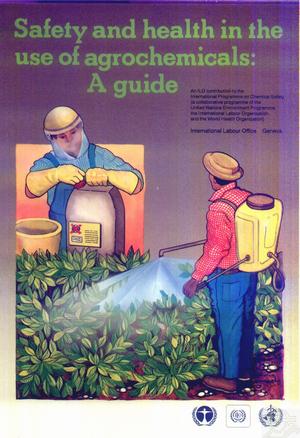Safety and health in the use of agrochemicals: A guide
İÇİNDEKİLERContents Preface Scope 1. Introduction 1.1 Needs and precautions 1.2 Grouping of agrochemicals 1.2.1 Pesticides 1.2.2 Commodity chemicals 1.2.3 On-farm veterinary products 1.2.4 Fertilisers Discussion and activities 2. Safety and health 2.1 How dangerous substances can enter the body 2.1.1 Inhalation 2.1.2 Skin absorption 2.1.3 Ingestion 2.1.4 Other 2.2 Classification and related measures 2.2.1 Classification 2.2.1.1 Toxicity 2.2.1.2 Irritancy 2.2.1.3 Corrosivity 2.2.1.4 Flammability 2.2.1.5 Explosivity 2.2.2 Labelling and relabelling 2.2.3 Chemical safety data sheets 2.2.4 Identification Discussion and activities 2.3 Safe handling and use 2.3.1 Packaging 2.3.2 Transport 2.3.3 Transfer 2.3.4 Storage 2.3.5 Dispensing 2.3.6 Pesticide application 2.3.6.1 Pre-spraying precautions 2.3.6.2 Precautions during application 2.3.6.3 Post-spraying precautions 2.3.6.4 Re-entry 2.3.7 Other agrochemical applications 2.3.8 Spillage 2.3.9 Disposal of containers and waste Discussion and activities 2.4 Operational control 2.4.1. Engineering control measures 2.4.2 Personal hygiene 2.4.3 Use of personal protective equipment 2.4.3.1 Head protection 2.4.3.2 Eye and face protection 2.4.3.3 Respiratory protection 2.4.3.4 Protective gloves 2.4.3.5 Working clothes 2.4.3.6 Selection, use and maintenance of personal protective equipment 2.4.4 The use of alternatives to agrochemicals 2.4.5 Prevention of poisoning 2.5 Other applications 2.5.1 Work in greenhouses and similar structures 2.5.2 Aerial spraying Discussion and activities 3. Poisoning by agrochemicals, its management and emergency response 3.1 Types of poisoning and injury 3.2 Symptoms of poisoning and injury 3.2.1 Poisoning 3.2.2 Irritant injury 3.3 First-aid treatment 3.3.1 In case of poisoning 3.3.2 In case of injury 3.4 Role of poison information centres 3.5 Effects of temperature and fire emergencies 3.5.1 Effects of temperature on agrochemicals 3.5.2 Fire prevention and fire-fighting 3.5.2.1 Emission of toxic gases 3.5.2.2 Choice of fire-extinguishing agents Discussion and activities 4. Roles and responsibilities 4.1 Role of manufacturers 4.1.1 Development and packaging 4.1.2 Advertising and marketing of agrochemicais 4.2 Role of government agencies 4.2.1 Product registration 4.2.2 Promulgating regulations 4.2.3 Provisions for enforcement and advisory services 4.2.4 International exchange of information 4.3 Role of retailers 4.4 Role of employers and their organisations 4.5 Role of workers and their organisations 4.6 Role of the public Discussion and activities 5. Education and training 5.1 Information 5.2 Workers' education 5.3 Public awareness 5.4 School education Discussion and activities 6. Safety and health in developing countries Case histories Discussion and activities Annexes A. Glossary B. Grouping of agrochemicals C. Chemical safety data sheets D. Glove performance E. Examples of agrochemicals with symptoms of poisoning F. List of references Tables 1. Which fire-extinguishing agent to use 2. Action of fire-extinguishing agents Figures 1. Applying pesticide dust to cattle to control lice 2. Oral dosing of sheep to control internal parasites 3. A tractor mounted with a fertiliser spreader 4. Inhalation 5. Skin absorption 6. Ingestion 7. Injecting a piglet with iron to prevent anaemia (care should be taken when handling injection needles) 8. All agrochemicals should be labelled or marked 9. Opening a correctly designed container 10. Loading pesticides on to a lorry 11. A correctly designed agrochemical store 12. Avoid exposing agrochemical containers to direct sunlight 15 13. Warning! Pesticide storage! No access to unauthorised persons! 14. Agrochemicals should be stored under lock and key 15. Always read the label before using agrochemicals 16. Set out the dispensing equipment in an uncluttered place 17. Wear the appropriate protective clothing when dispensing agrochemicals 18. Pour correctly from large containers with the spout uppermost 19. Look out for overhead electricity cables 20. Correct method of using a knapsack sprayer 21. When spraying trees, take notice of wind speed and direction 22. Clean thoroughly all equipment used for application of agrochemicals. Take care not to contaminate the environment with waste water 23. Avoid contamination from animals shaking themselves after a pesticide dip 24. Use personal protective clothing when dipping animals 25. Personal protective clothing appropriate for working with hydrofluoric acid 26. Using sand to contain and remove an agrochemical spill 27. Containers and waste should be buried at a depth of 1 metre 28. Choose a safe disposal site for burying agrochemical waste 29. Burning agrochemical containers 30. Safe use of knapsack sprayers by improved design and engineering control measures 31. Safe use of trailed crop sprayers by improved design and engineering control measures 32. Flow diagram of a field sprayer fitted with a pesticide induction bowl 33. A user wearing protective clothing and filling a pre-mix bowl on a crop sprayer 34. Thoroughly wash exposed parts of the body 35. Personal protective clothing should be washed after use 36. Examples of personal protective equipment 37. Examples of protective clothing and equipment for work with highly toxic chemicals 38. Select the appropriate type of personal protective equipment (ask someone who knows) 39. Protective clothing and equipment should be worn and used correctly 40. Boots used during agrochemical application must be washed before removal to prevent contamination 41. Protective clothing and equipment should be stored in separate accommodation 42. Work in a greenhouse involves many risks associated with agrochemicals 43. Aerial spraying of pesticides 44. Irritant injury (blistering caused by contact with toxic agrochemicals) 45. Remove the casualty to an uncontaminated place 46. If agrochemicals enter the eyes, wash thoroughly with clean running water 47. A casualty placed in the recovery position 48. Progress chart for the registration and approval of agrochemicals for safety and efficiency 49. Enforcement authorities should provide technical advice on safety and health in the use of agrochemicals 50. A community leader receives information and documentation from an enforcement/agricultural extension officer 51. Training workshop at a community centre 52. Community leaders have an important role to play in educating farmers 53. Prevent children from playing in treated areas 54. Sample record of agrochemical application 55. Pictograms for agrochemical labels    |



